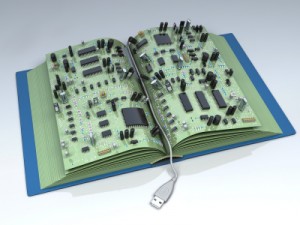Guest post–Revolution #9: Thoughts on Electronic Publishing Vs. “Traditional” Print Publishing
Those thinking that they can successfully continue with a traditional model of publishing for an unlimited time are as delusive as a historical Luddite thinking a solid sledgehammer blow capable of holding back the forces of industrialization. It is human nature to yearn for next year’s model. We are clever monkeys – we tweak, we twiddle, and of such moments Progress is made. Accordingly, while the metaphor of the page will continue, I suspect, for centuries, the everyday object is doomed to be replaced — made obsolete within the next century.
Books may survive, but in the form of curiosities rather than staples. One by one, we’ll see the various manifestations of books challenged by electronic publishing in the coming years.
Most will fall, while those that remain will most probably find themselves dramatically and irrevocably changed. Paper textbooks will be among the first to go — are in the process of doing so right now, in fact, and who, remembering the days of ten pound science texts, can not count that as progress? Children’s books, with their emphasis on texture and art, will last much longer. As for the common paperback, well — once the Sony BeachReader, which I’m sure is due out any day now in six waterproof colors, appears, vacation reading will shift dramatically.
Those who claim that online publishing and its adherents are killing traditional publishing are being disingenuous, blaming the small mammals supplanting the dinosaurs for bringing them down. If anything, at the moment online publishing is helping traditional publishing by encouraging the love of reading that pulls one into a bricks and mortar bookstore.
2. Let’s look beyond the abstract to material circumstances, to a world, particularly an America, learning that unchecked consumption may not be possible going forward. Here’s a major reason why online publishing will overcome paper: electronic publishing requires less space and fewer trees. 30 million trees are consumed each year for books printed for US consumption alone. Similarly, as we move towards using less space, rather than more, which is preferable: the electronic device that holds five hundred books or those books, consuming precious cubic feet of storage?
3. Those who love the book in its traditional form, who relish the feel of pages bound in leather, the heft and smell and sound of paper pages, will always exist. However, as time passes, there will be fewer and fewer of them. Books in that form will become retro, vintage, classic, the form itself a semiotic marker for a particular lifestyle.
4. Text itself will probably survive. It is an extremely efficient means of delivering information, falling short only of beaming it directly into one’s brain (which I would also bet is coming at some point.) Beyond that efficiency, there is pleasure to consuming text, to soaking oneself in a dreamy bath of words or of listening to the cadences of well-constructed sentences. But text can be consumed as easily from a screen as from the page.
5. The issue of piracy has complicated discussions of electronic publishing. The ease of publishing electronically is both strength and weakness because it makes unauthorized reproduction easy as well. To my mind, it is the folk who follow the basic model of the Internet, the idea that information wants to flow, that it MUST flow, that will do the best in earning their living from it. The old model of handing someone a thing in return for money does not translate well in the world of electronic publishing.
Some folks have taken to a model where work, distributed for free, drives up the sales of other words. This electronic exposure = sales model has worked well for some, such as Baen Books’ Eric Flint, author John Scalzi, and net advocate/writer Cory Doctorow. For them it’s worked; others have tried and not succeeded as well.
The business model best suited to the Internet is still in the process of being discovered. We’ve seen ideas raised that include micropayments, donations, selling linked merchandise, advertising, subscriptions, syndication, and much more. This makes being an online publication interesting, but with electronic publishing it’s easy to change, to shift, to try new strategies, discarding the nonworking and embracing that which yields results. I suspect that any model will have to take the phenomenon of piracy as a given, and that models that incorporate and try to use it that will fare the best.
But one important difference is that the story that, having been read, perhaps passed along to a couple of other readers, and finally ended up in the recycling bin, is gone. Meanwhile its counterpart on the web remains, continues drawing readers – and can still be accompanied by a working ad.
6. One of the things that changes the business model is that technology can add much to text, starting with presentation. Technology allows text to be tailored to the user. For example, an e-reader allowing the reader to zooming in on the text or adjusting the brightness so it can be read in sunlight. You can fiddle with the color of the page, or whether or not illustrations are displayed, or the type of font that is used. The reading can be tailored to the reader in a way that print publishing finds prohibitively expensive.
7. Technology can also add intertexuality to the text. Technology allows text to be accompanied by information that illustrates, explains, exemplifies. Not sure what that word means? Click on it to find out. Bring up a sidebar that explains the difference between guineas and pounds in James Joyce’s Ulysses, or a screen that lets you listen to it read aloud in the right accent.
8. Technology allows text to change and to do so as rapidly as human knowledge changes. Text can be updated to reflect current discoveries as quickly as they are made. Is a fact wrong? A reader can make a note of that fact and an editor correct it in the time it takes to fact-check and edit. As new texts are produced that may add to the understanding of the original one, it can be amended to point to them. While the fluidity of knowledge can be problematic, given the attempts of corporations and governments to control its manifestation on the internet, the vast number of readers makes it difficult for them to do so, as can be glimpsed in the daily struggles and fluctuations of Wikipedia. Text can be updated, edited, translated, illustrated, reproduced, transfigured, in an editor or publisher’s hands, in a place where anyone can be an editor or publisher.
9. The addition of community to the text creates powerful marketing possibilities. Impressed by a piece of writing and want to discuss it with other readers? Social networks such as GoodReads and LibraryThing make this possible, and amplify the power of word of mouth to sell books. Certainly this can be used to sell physical texts, but again, which recommendation is another reader likely to act on, one that forces them to the car in order to consume gas driving to the local mall or asks them to wait while their order is shipped to them, or the one that allows instant gratification with only a mouse-click?
Online community allows one to find fellow readers who share a love of the most obscure text, and allows discoveries to be passed along with the knowledge of where to find them. With a global community of readers, publishing to niche markets becomes a more viable form of publishing, allowing a publisher to readily find the market/community suited to a specific genre, writer, or topic.
Online magazines abound, including Clarkesworld, Strange Horizons, Fantasy Magazine, Abyss & Apex, and Beneath Ceaseless Skies. For them, selling advertising is a viable means of making money. This is particularly true since online content remains online. For example, at Fantasy Magazine we’ve got an article from 2008 that continues to gather a substantial number of hits each month.
Furthermore, building community provides groups that may buy subscriptions, make donations, or otherwise financially support the publication, which is one of the reasons Fantasy Magazine has focused recently on social networks, such as Facebook, Twitter, Livejournal, and StumbleUpon.
The future of publishing may well lie in the survival of such magazines. Online publishing has much to offer beyond the ability to change a font color or add a link, as it continues to grow into new forms. Interactive text, where reader and writer collaborate, or text which shifts randomly in accordance to algorithms buried in the page, texts that are games or directions or forms we haven’t begun to imagine yet, all lie before us. While books remain in our hands, the time may come when more and more of us are tempted to lay them down, at least part of the time, for the sparkly promise of electronic publication, an art form only just beginning to emerge.
—
 Cat Rambo lives and writes in the Pacific Northwest. Her collection, Eyes Like Sky And Coal And Moonlight, is an Endeavor Award finalist this year. Both it and The Surgeon’s Tale And Other Stories (with Jeff VanderMeer) are available on Amazon.com. She is the fiction editor of Fantasy Magazine. Upcoming appearances include the Write on the River workshop, SteamCon and World Fantasy Con. Her website appears at http://www.kittywumpus.net.
Cat Rambo lives and writes in the Pacific Northwest. Her collection, Eyes Like Sky And Coal And Moonlight, is an Endeavor Award finalist this year. Both it and The Surgeon’s Tale And Other Stories (with Jeff VanderMeer) are available on Amazon.com. She is the fiction editor of Fantasy Magazine. Upcoming appearances include the Write on the River workshop, SteamCon and World Fantasy Con. Her website appears at http://www.kittywumpus.net.



